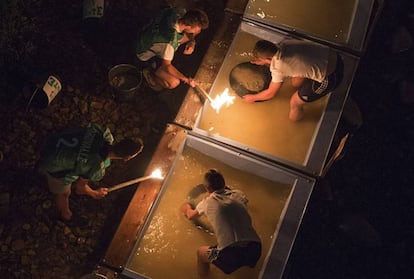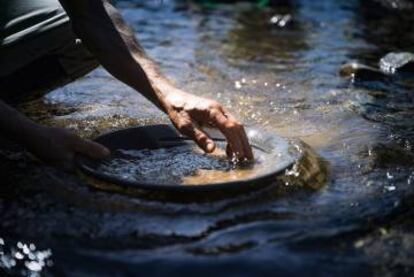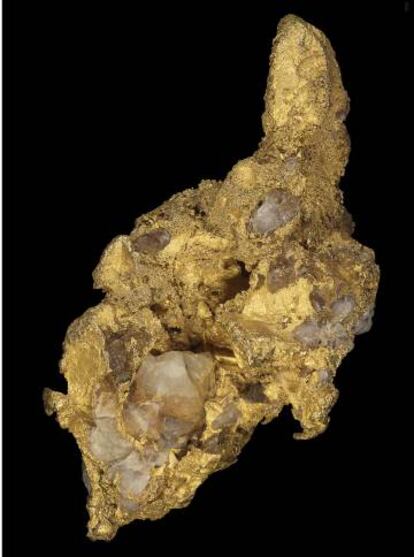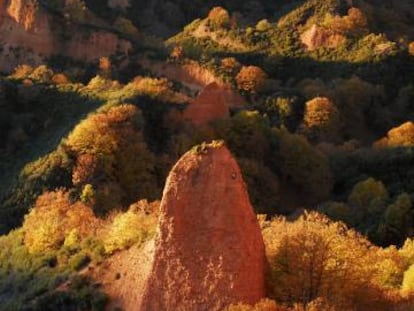Panning for pleasure: How Spain is enjoying a new kind of gold rush
Modern-day prospectors flocking to Asturias are no longer seeking wealth, but excitement instead

“Nobody ever went out to the river with a Sanfiz and didn’t spot gold,” says Luis Sanfiz confidently, standing at the mouth of the Roman mine of Entrepeñas, in the small locality of Navelgas, in Spain’s mountainous Asturias region.

His father, Enrique Sanfiz, was a miner here when a company named Aurífera Asturiana reopened the site for five years in the mid-20th century. When the working day was over, Sanfiz and another miner named Eustaquio Fernández would pick up a pan and starting washing off piles of dirt. Often, there would be fine golden sheets lying at the bottom of the pan.
He never found anything big, but nearly always got something, and he would sell it to dentists
Luis Sanfiz, son of Enrique Sanfiz
“Neighbors used to say he was crazy. They laughed at him because he was always looking. He dreamed of finding a good nugget. He never found anything big, but nearly always got something, and he would sell it to dentists,” recalls his son Luis.
At that point, hardly anyone in Navelgas remembered that many centuries earlier, even before the Romans showed up, people were already panning for gold. It is an ancient tradition called “bateo” in Spanish, because prospectors use a pan called a “batea.” This tool was traditionally used in gold-rich areas as a manual way to find lodes: if gold particles showed up in the river, they might be coming from a nearby vein. Metal detectors relegated this practice to oblivion. Or almost. There were always a few people like Eustaquio and Enrique who still knew how to handle a pan.

Enrique Sanfiz died in 1992 at age 82, but he had 16 children and he taught them all the art of gold panning. They in turn showed their friends, who were bitten by the bug. Little by little, gold fever made a comeback in Navelgas. Nobody calls the Sanfizes crazy anymore, and it is easy to find entire families searching the river bed – not to make a living, since there is little money to be had from this – but simply for fun. The new gold panners are not after riches, but after the excitement of seeing the shine of gold at the bottom of their pans.
“This is a good pastime where you can enjoy nature, like fishing. Years ago maybe it was easier to make a little money on the side, but these days the entire mountain has been mined. You would have to pan 10 tons of earth to put together one gram of gold. At €40 a gram, this is clearly not a profitable activity,” says Luis, 53, who is the youngest of the siblings. “I’ve never sold anything that I’ve taken out. I keep it as a souvenir.”
This is a good pastime to enjoy nature, like fishing
Luis Sanfiz
So how much gold has he found in the half a century that he has been panning? “Bah... I’ve had up to half a kilogram, but I’ve given a lot of it away,” he says, showing off a collection of small nuggets delicately placed inside a display case. He will not reveal how many more he has at home.
It’s easy to learn how to pan. You just need patience, good eyesight and a strong back to resist the crouching position. But it’s not so easy to know where to look.
“You really have to know the mountain. And the Sanfizes are masters at that. I’ve been looking for years, but I never find as much as when I go out with one of them,” admits Manolo Rodríguez, who was born in Navelgas but now lives in Gijón, the largest city in Asturias. “But that’s the least of it. What I enjoy is spending time in the river, bringing a sandwich with me and getting lost in the woods all day,” he explains. Yet Manolo proudly shows off a test tube filled with gold. “It’s taken me years to fill this,” he explains.

In the early 1990s, the first tourists began to arrive. They wanted to pan for gold, just like people were doing in other small villages in countries with a great gold mining tradition such as Canada, the United States, Finland and Australia. Some of these villages cooperated to create an international gold panning competition. With financial support from the painter Manuel García Linares, himself a native of Navelgas, the locals formed a small team with the brothers Luis and Carlos Sanfiz to compete in the 1995 championship in France. They were in for a shock.
“The competition was tremendous. We had experience in the river, where speed is not the main thing. But those people were practiced at speed. They had these pans called turbos which we’d never seen in our lives!” recalls Luis.
Undeterred, the following year they entered the competition again, which was held in Canada this time. In 1997 they competed in Italy, and Luis Sanfiz reached the semi-finals. At that point, Navelgas created a panner association called Asociación de Bateadores Barciaeus to organize a national championship.
Fans really enjoy the challenge of making out the shiny nuggets in the dark
The first one took place in 1999, and it has been continuously held every summer since then. At the last edition, held last weekend, there were more than 150 participants of all ages. The rules are simple: each contestant gets a bucket filled with sand and several nuggets. The winner is the person who finds the most nuggets in the least amount of time. There is even a nighttime category, which fans really enjoy because of the added challenge of making out the shiny nuggets in the dark.
In 2005, Navelgas hosted the European championship, and even managed to host the world event twice, in 2008 and 2015. The Spanish team, made up of 40 registered association members, will travel to Scotland this weekend to compete in the international championship to be held in Moffat between August 7 and 12.
In 2006, Navelgas inaugurated its own Gold Museum, which explains the history of gold mining in the region and exhibits a replica of the largest nugget ever found in the area using the panning technique: it weighs 27.8 grams and was found in 2001 by Enrique Sanfiz, the pioneer’s grandson.
Golden love?
These championships are about more than competing. At the national competition inauguration last Friday, there was Asturian food on display and a live band. Participants included David and Nuria, a young couple from Madrid who took up panning after watching a documentary on television. And there was Marteen Jacobs, a Dutch engineer who moved to Gijón after meeting the woman of his dreams, a native of Navelgas, at the 2001 European championship in France.
“A lot of couples have met while panning,” says Marteen. “Some of them have their wedding rings made out of the gold they’ve found. In 2008, another Dutchman like myself fell in love with another girl from Navelgas, and now he lives in Asturias too.”

Panning is increasingly popular in Asturias but also in the northern regions of Galicia and León – particularly around the famous Roman mines of Las Médulas, and around the gold-rich fault that runs through Zamora, Salamanca and Extremadura, where large nuggets weighing up to 50 grams have turned up.
“There are lots of nuggets in that area. The good thing is that they are very scattered, so industrial mining is not profitable, which is lucky for fans. It’s also not worth it to melt them down, because the nugget itself is worth a lot more than the metal,” explains Santos Barrios, a geologist, expert panner and collector.
In 1997, a farmer named Felipe González accidentally found a nugget weighing 8.5 grams as he was changing the wheel of his tractor in Talarrubias (Badajoz). Researchers say that this location and the nearby Casas de Don Pedro currently have the largest reserve of gold nuggets in Spain. In 2002, the same farmer found the largest nugget on record in Spain, which even has a name: Doña María José, weighing 218 grams.
Nobody knows how much gold still lies underground in the Iberian Peninsula. Or how much is stashed away inside the homes of panners
There were probably even bigger ones in the past, but there were no collectors then, and finders would typically melt them down. Still, it is hard to believe that such nuggets still exist in Spain at this point in history.
“It is widely believed that the Romans took it all. And that’s partly true,” says Rafael Lozano, a geologist at the Geology and Mining Institute of Spain. “In that part of Extremadura, for instance, there is not a lot of fine gold in the rivers. If you pan, you hardly find anything. Maybe that is why the Romans thought there were no veins nearby.”
Nobody knows how much gold still lies underground in the Iberian Peninsula. Or how much is stashed away inside the homes of panners.
“Gold has always generated mistrust. In small villages there are lots of people who have nuggets but they don’t show them out of fear of being robbed. Some nuggets get sold to collectors. Very few people show off everything they’ve got,” notes Barrios.
Greed may no longer be the driving force behind gold panning, but the shine of the most precious metal of all still elicits strong emotions.
English version by Susana Urra.
Tu suscripción se está usando en otro dispositivo
¿Quieres añadir otro usuario a tu suscripción?
Si continúas leyendo en este dispositivo, no se podrá leer en el otro.
FlechaTu suscripción se está usando en otro dispositivo y solo puedes acceder a EL PAÍS desde un dispositivo a la vez.
Si quieres compartir tu cuenta, cambia tu suscripción a la modalidad Premium, así podrás añadir otro usuario. Cada uno accederá con su propia cuenta de email, lo que os permitirá personalizar vuestra experiencia en EL PAÍS.
¿Tienes una suscripción de empresa? Accede aquí para contratar más cuentas.
En el caso de no saber quién está usando tu cuenta, te recomendamos cambiar tu contraseña aquí.
Si decides continuar compartiendo tu cuenta, este mensaje se mostrará en tu dispositivo y en el de la otra persona que está usando tu cuenta de forma indefinida, afectando a tu experiencia de lectura. Puedes consultar aquí los términos y condiciones de la suscripción digital.
More information
Archived In
Últimas noticias
Tiger Woods turns 50: Will he continue playing on the PGA Tour or take a back seat?
The surreal journey of James Nnaji, the Barcelona youth player selected in the NBA Draft who ended up in the NCAA
Trump claims peace in Ukraine is near, but Moscow suggests otherwise
A survivor’s account of the Interoceanic Train accident: ‘We were scared because of the speed on the curve’
Most viewed
- Oona Chaplin: ‘I told James Cameron that I was living in a treehouse and starting a permaculture project with a friend’
- Reinhard Genzel, Nobel laureate in physics: ‘One-minute videos will never give you the truth’
- Why the price of coffee has skyrocketed: from Brazilian plantations to specialty coffee houses
- Pablo Escobar’s hippos: A serious environmental problem, 40 years on
- Chevy Chase, the beloved comedian who was a monster off camera: ‘Not everyone hated him, just the people who’ve worked with him’










































